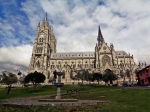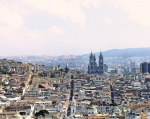Information about Quito
Quito is the capital of the Republic of Ecuador and has around 2.7 million inhabitants.
The economic activity is very varied, here is where most of the actions of the automotive industry is concentrated, especially in the assembly for national consumption and export, the largest construction activity in the whole country, it is the first national exporter of flowers, wood, non-traditional products such as palmetto and asparagus and several more from their valleys.
The whole city and the metropolitan district are between the Contemporary and Colonial styles, which are constantly being reconstructed day by day. The modern structure is mixed with the colonial one where national residents and foreign visitors always find a place to work, enjoy and remember.
The history of the city of Quito dates back to times before the Christian era. It is known that the area today occupied by Quito was populated at least since 900 a. In pre-Inca times the importance of Quito was based more on its strategic location than on its political status. It was the center of of the routes between the main towns of the zone and therefore it was the axis of an intense commercial interchange.
For the Incas, this region seems to have had an analogous importance. Caranqui, for example, was an urban center of greater political and administrative importance than Quito. In fact, few archaeological remains have been found that demonstrate a significant Inca occupation.
The Inca conquest of the area occupied by the current Ecuador was initiated by Topa Inca Yupanqui, son of Pachacutec, the founder of the empire. And, it was Huayna Capac, son of the first, the first Inca who established his residence in Ecuadorian lands in Tomebamba, the current Cuenca.
Due to the early arrival of Pedro de Alvarado to the region by Bahía de Caráquez and Puerto Viejo, therefore to avoid major setbacks, on August 15, 1534, Diego de Almagro, urged by time, founded the city of Santiago del Quito in the plains of Riobamba. In this way, he took possession of the lands for the jurisdiction of Francisco Pizarro. That attitude truncated the ambitions of Alvarado, who obligatorily had to agree with his compatriots. Days later, in the same place that Diego de Almagro founded the city of Santiago de Quito, on August 28, 1534, happened what several historians call the remote foundation of San Francisco de Quito. The ceremony included the formation of the town hall or colonial chapter of the new Villa, with the legal oath of two mayors and eight council members. The notary Gonzalo Díaz corresponded to him to attest to the executed act.





